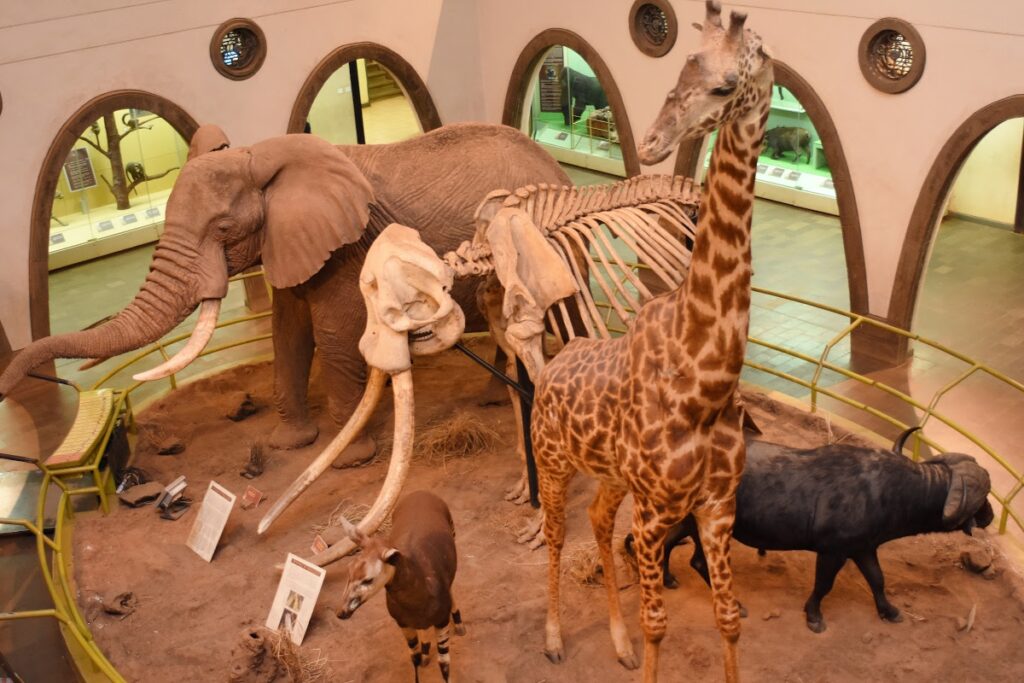

Nairobi National Museum Tour
- The Hall of Kenya.
- The Joy Adamson gallery.
- The Cycles of Life.
- The Birds of East Africa gallery.
- The Great Hall of Mammals.
- Ahmed the Elephant.
- The Cradle of Mankind.
- Historia ya Kenya.
- Temporary exhibitions.
Nairobi National Museum Tour
Welcome to Nairobi National Museum tour, which tells the story of Kenya’s rich heritage. The museum’s mission is to collect, preserve, study, document and present Kenya’s past and present cultural and natural heritage. This is for the purposes of enhancing knowledge, appreciation, respect and sustainable utilization of these resources for the benefit of Kenya and the world, for now and posterity.
The Hall of Kenya

The Hall of Kenya is dedicated to highlight the country’s unique tangible and intangible heritage. In this gallery Kenya’s nature, culture and history meet. All in all the objects on display are a testimony to the country’s diverse and rich heritage. All the information on display, the objects, and all research works can be found in the Cultural Anthropology department at the museum.
The Joy Adamson gallery
Joy Adamson (1910–1980) was an illustrator, conservationist and author. She is known for her contribution to the conservation of Kenya’s natural and cultural heritage, winning her international acclaim. Joy Adamson was a colorful, if at times controversial, character whose work continues to affect how people view conservation. Much of her work is immortalized not only in her illustrations, but in her books and films, which have been pivotal to preserve the diversity and richness of Kenya’s people and nature. Because of Joy’s inspirational efforts, people around the world now consider how they can preserve their own cultural and natural heritage. Additionally all works by Joy Adamson are housed at the Archives section in the Earth Sciences department at the museum.
The Cycles of Life
Life amongst Kenyan communities is filtered through different stages. From birth, through youth to old age, death and transition into ancestry. This gallery samples cultural practices from Kenya’s communities as associated with these different stages in life. Certainly there is a wealth of material and intangible cultural heritage to be appreciated in this gallery. All information on display here can be found in the Cultural Anthropology department at the museum.
The Birds of East Africa Gallery
They came from far and wide, in all colors and sizes, from the most primitive to the most advanced and found a home in the Birds of East Africa gallery also showcasing the rich diversity of birds in the region. The Osteology section in the Zoology department keeps all the information showcased here.
The Great Hall of Mammals
The Great Hall of Mammals traces the development of mammals over time, with a focus on their adaptations to movement, feeding and protection. By and large the gallery confronts the visitor with points of congruence as well as divergence in the make up of the mammalian world. Furthermore to access further information, the Mammology section in the Zoology department are the ones to consult with.
Ahmed the Elephant
Perhaps the most famous elephant in the world, Ahmed is known for his large tusks and put under 24 hour protection in Marsabit National Park by Kenya’s first president, Kenyatta. Ahmed’s skeleton, with the original tusks, can be found in The Great Hall of Mammals inside the museum and a life-size model can be found in the courtyard of the main gallery building.
The Cradle of Mankind
A unique collection, which points to Kenya as the cradle of humankind, is on display in this gallery. Moreover the gallery traces human existence as evidenced by fossil findings across Kenya. Generally information, artifacts (fossils) and research work can be accessed through the Earth Sciences department at the museum.
Historia ya Kenya
The gallery highlights Kenya’s history in three major phases: pre-colonial Kenya, the period of colonial rule, and independent Kenya. Key historical events that have shaped the lives of Kenyans are highlighted, including the Kenya-Uganda Railway, land alienation, and the two world wars. For more information on Kenya’s history, the Cultural Anthropology department has it all.
Temporary exhibitions
Subsequently the museum’s temporary galleries highlight some of the most exciting contemporary artists and aspects of Kenya and Africa. The Museum extends services to individuals and institutions that wish to exhibit any information they deem important. A great example would be that of the Central Bank of Kenya (CBK) who created an exhibition on the Kenya shilling’s evolving history, dubbed ‘the Numismatic Exhibition’.
End of servicesB
- Transport.
- Entrance fees.
- Bottled Water.
- International Air Fares.
- Visas.
- Expenses of personal nature such as travel/baggage insurance,laundry, beverages, tips etc